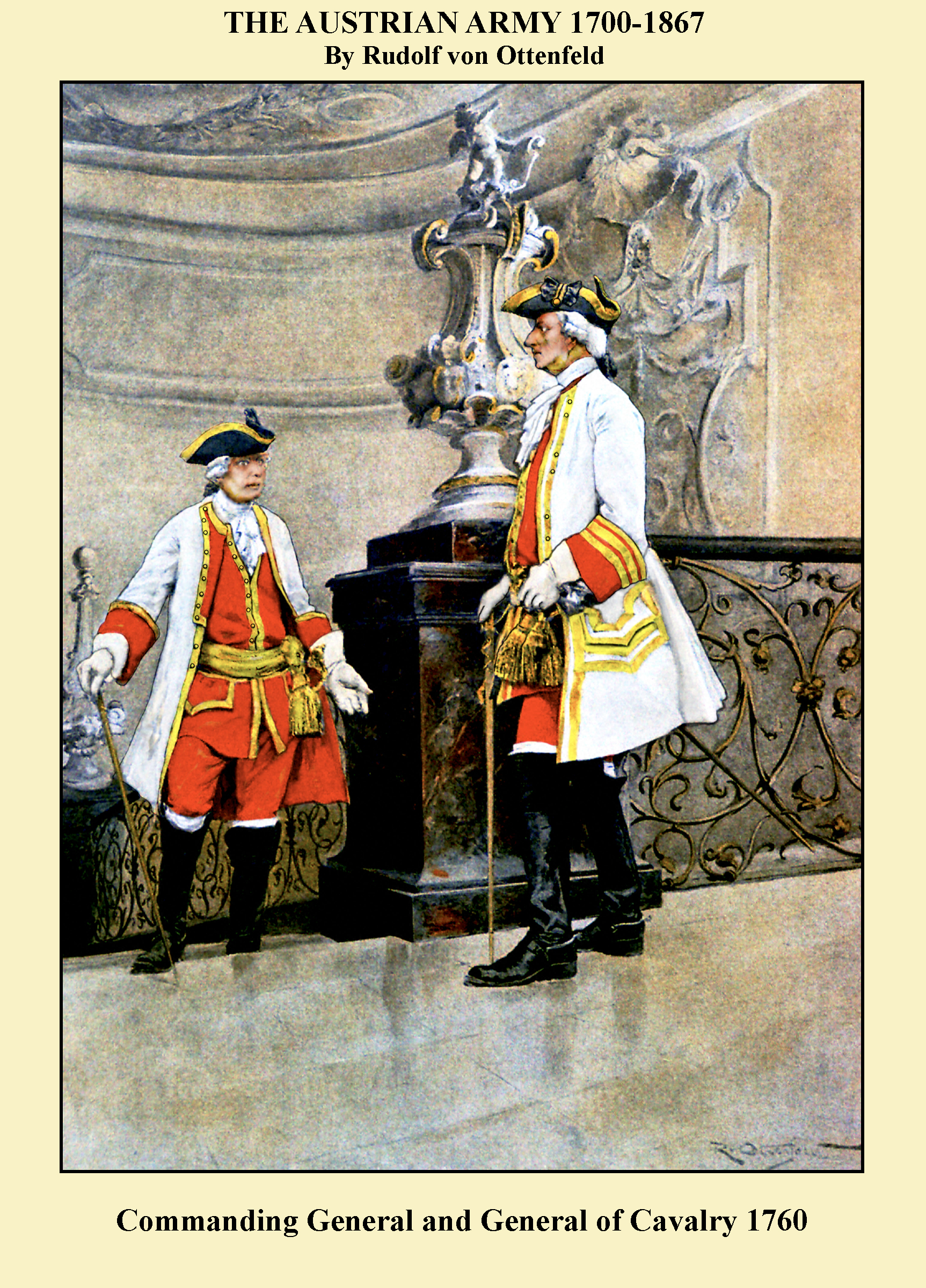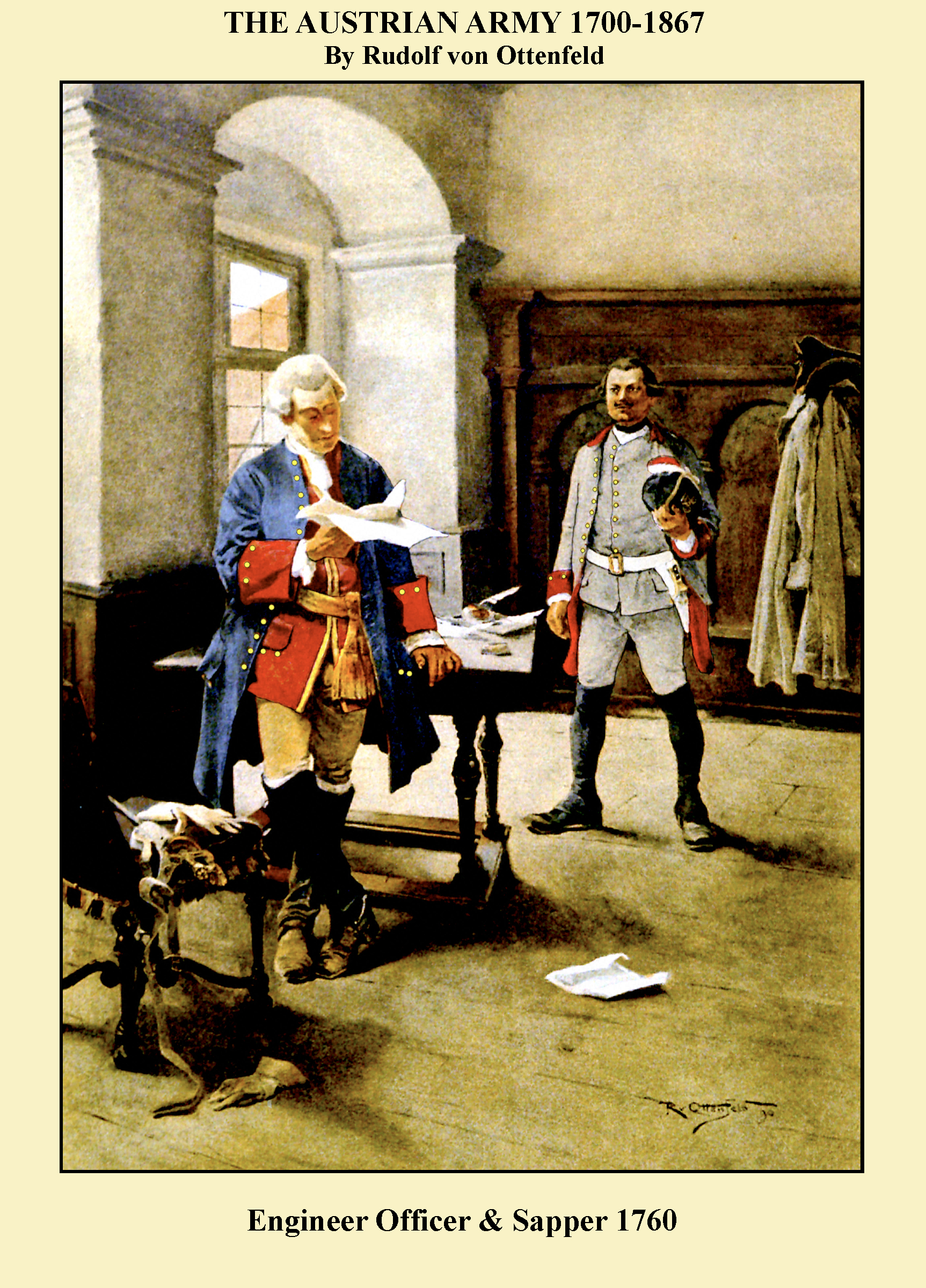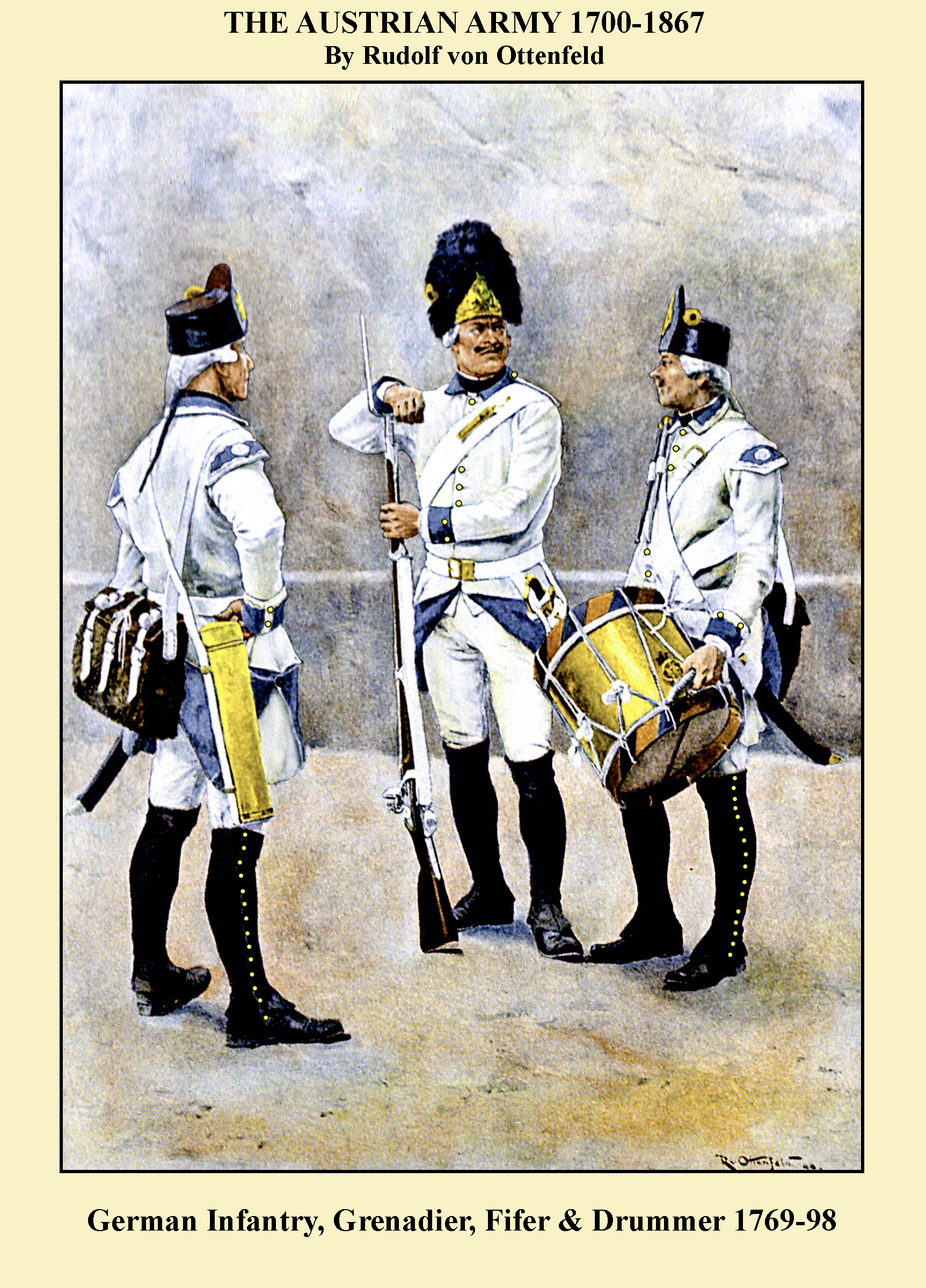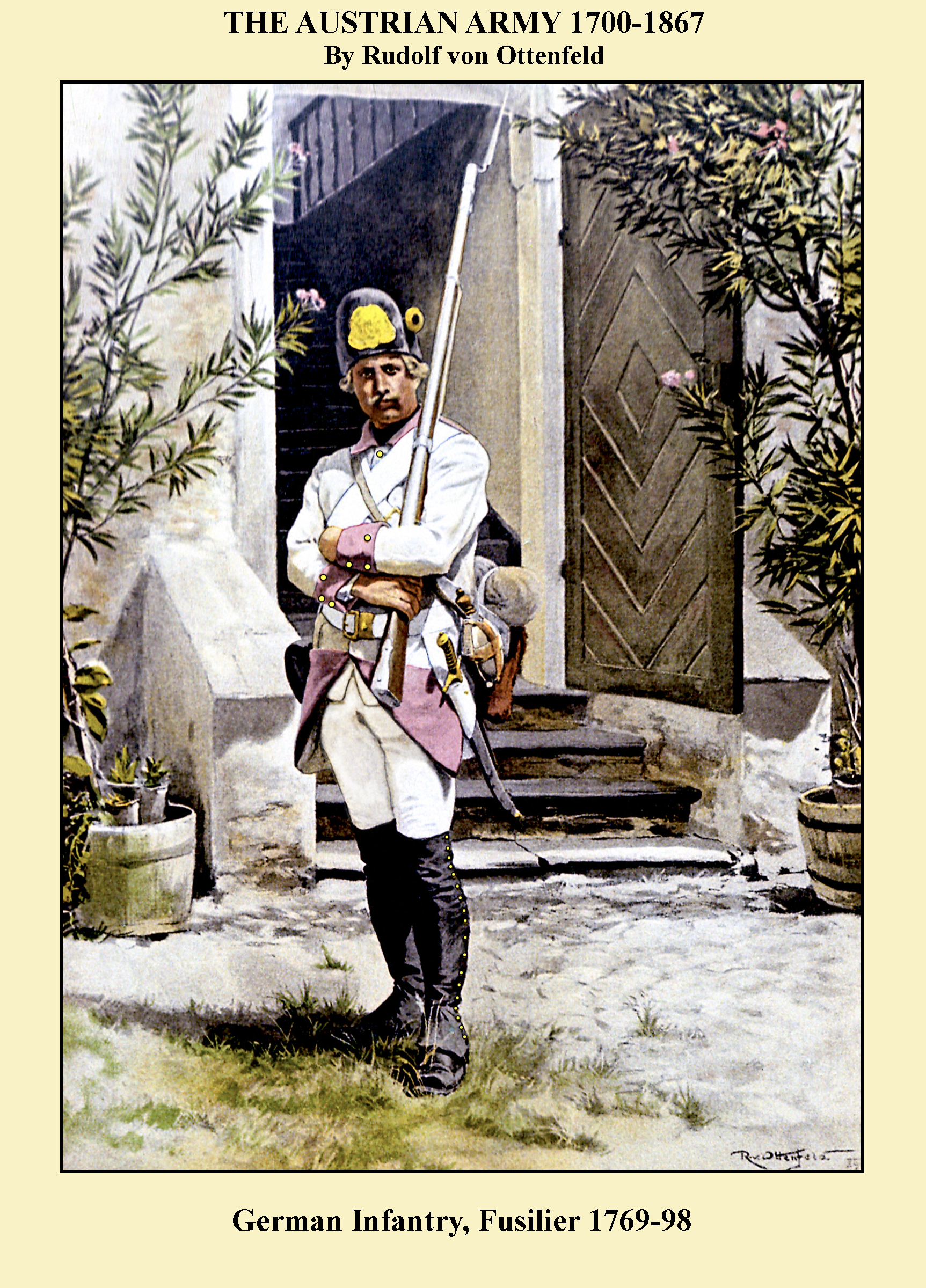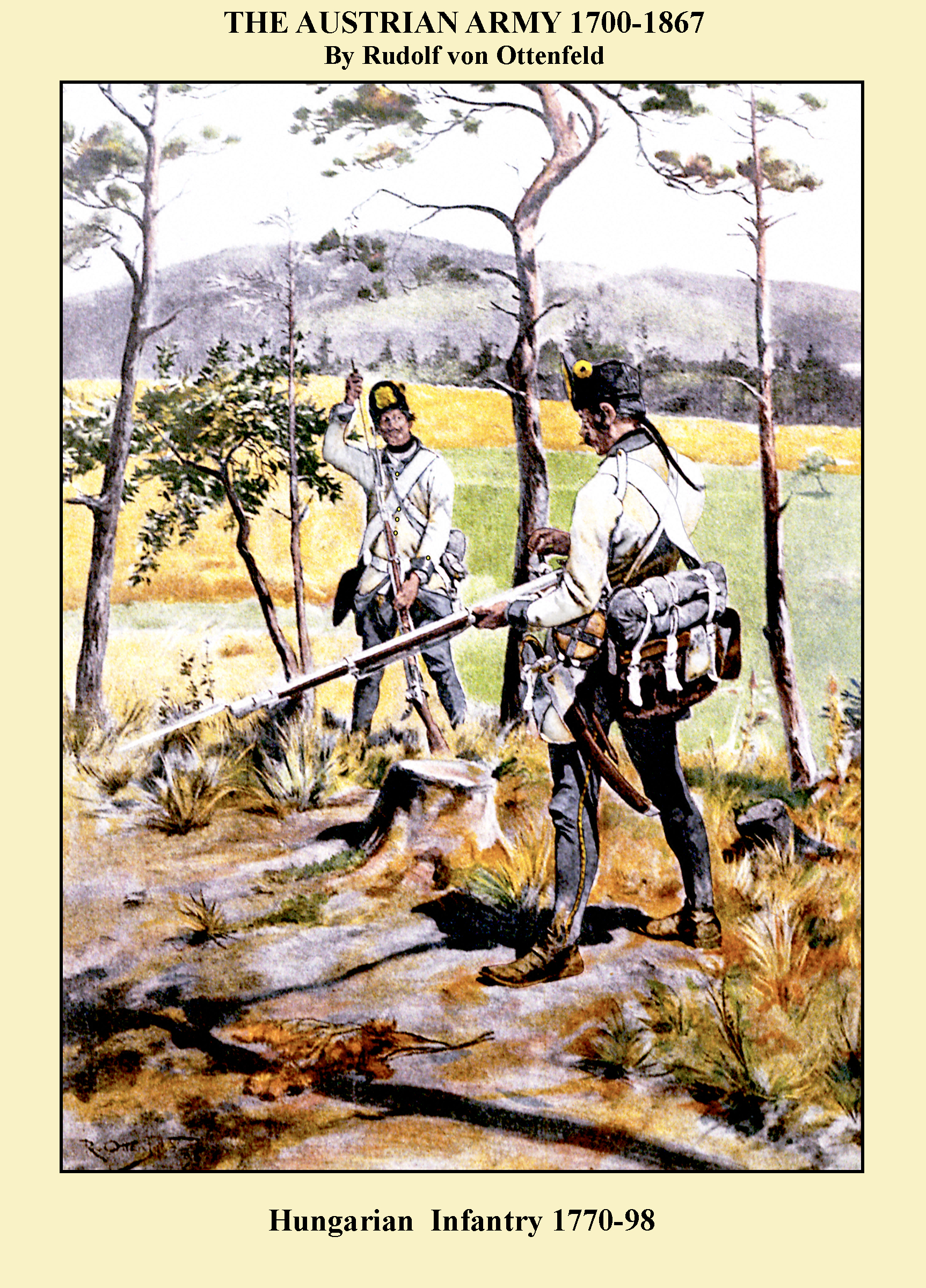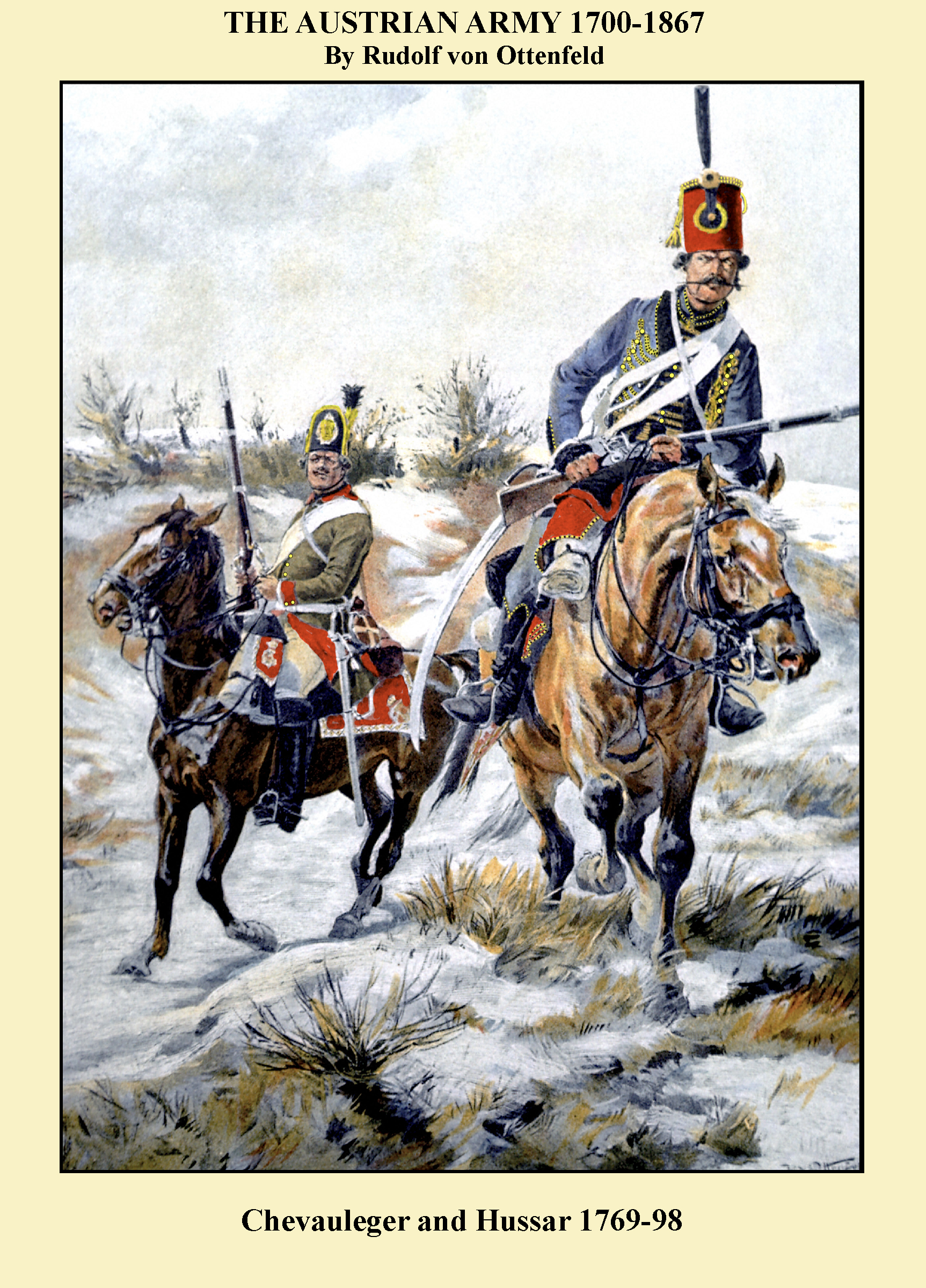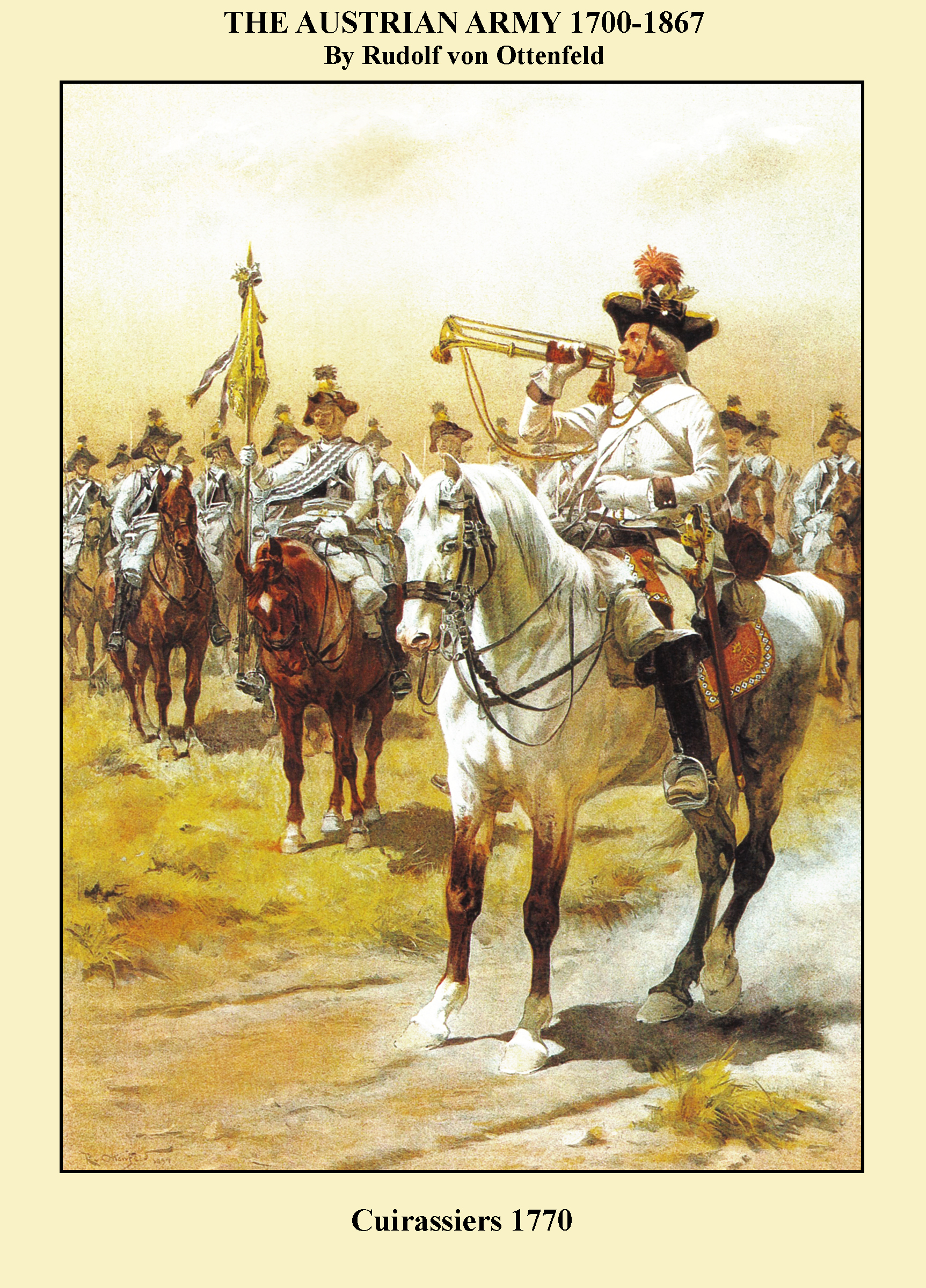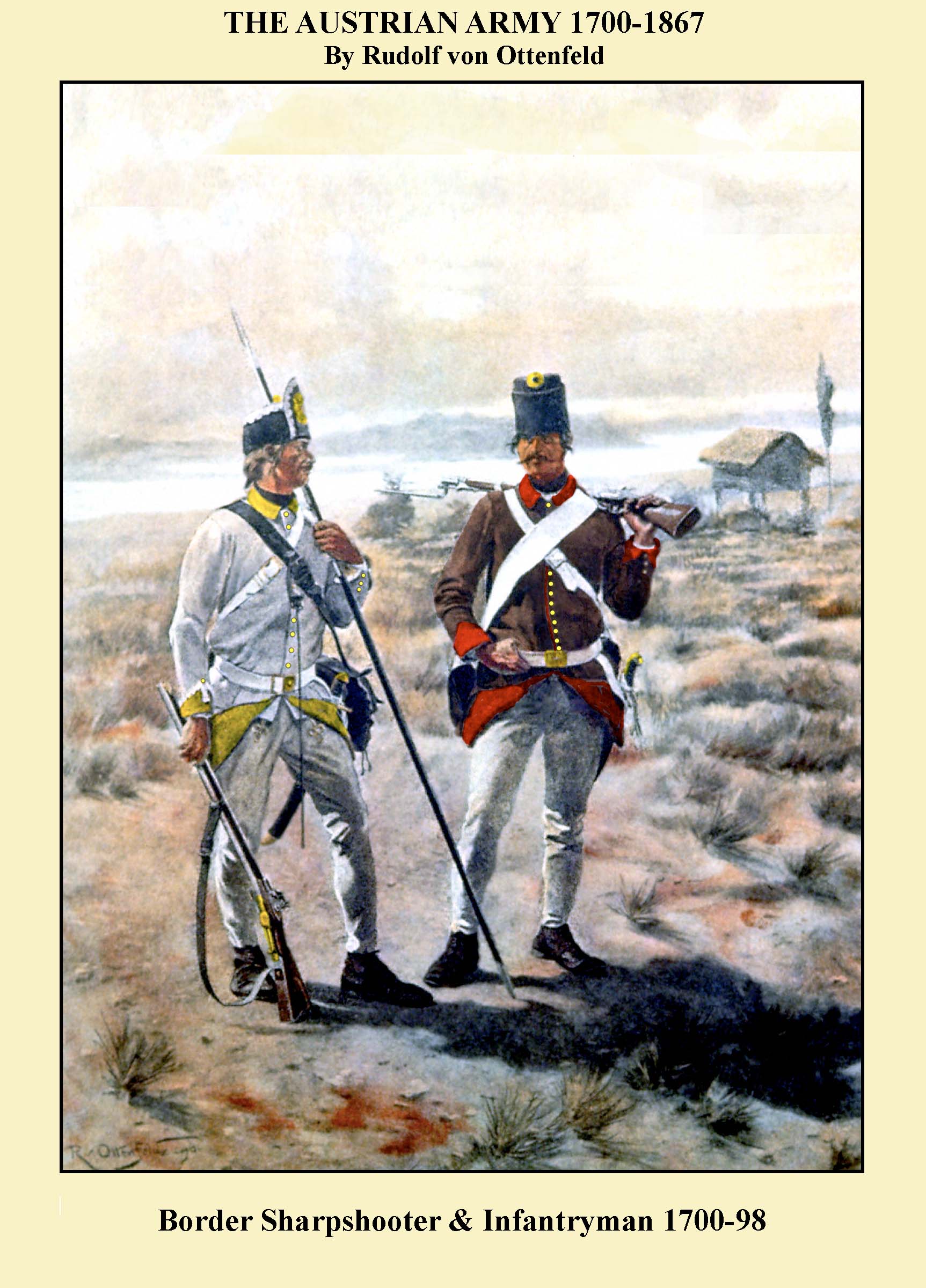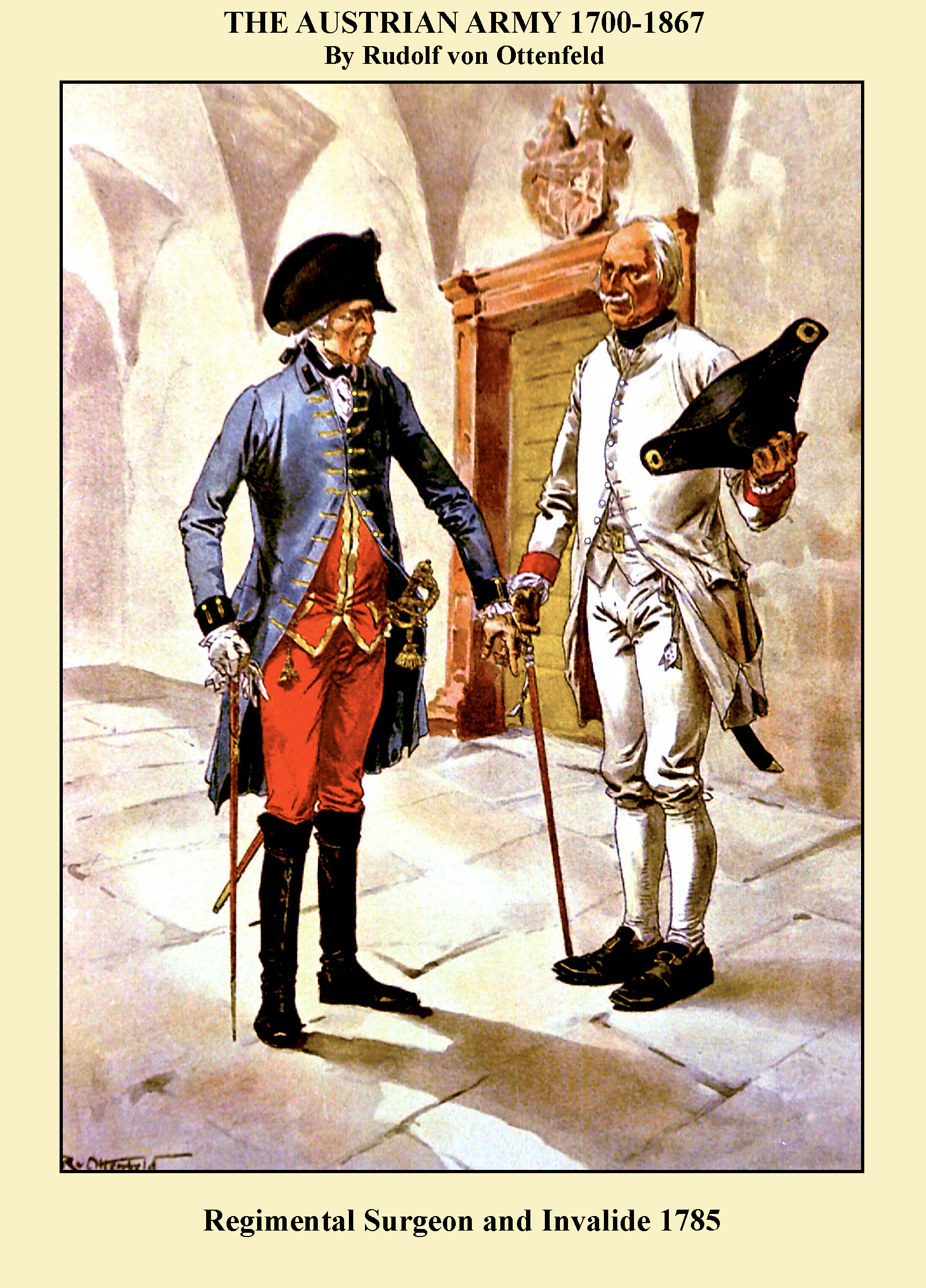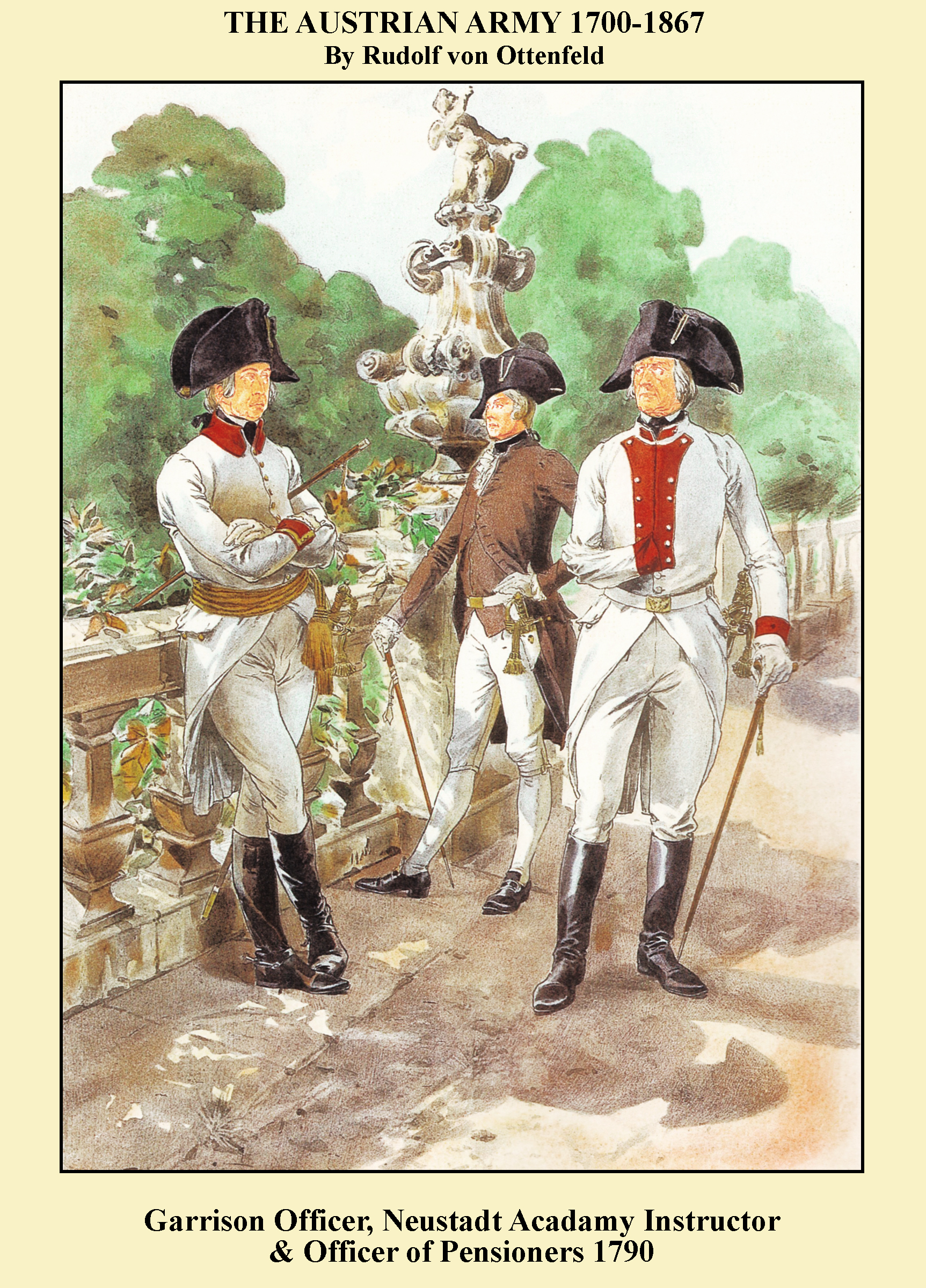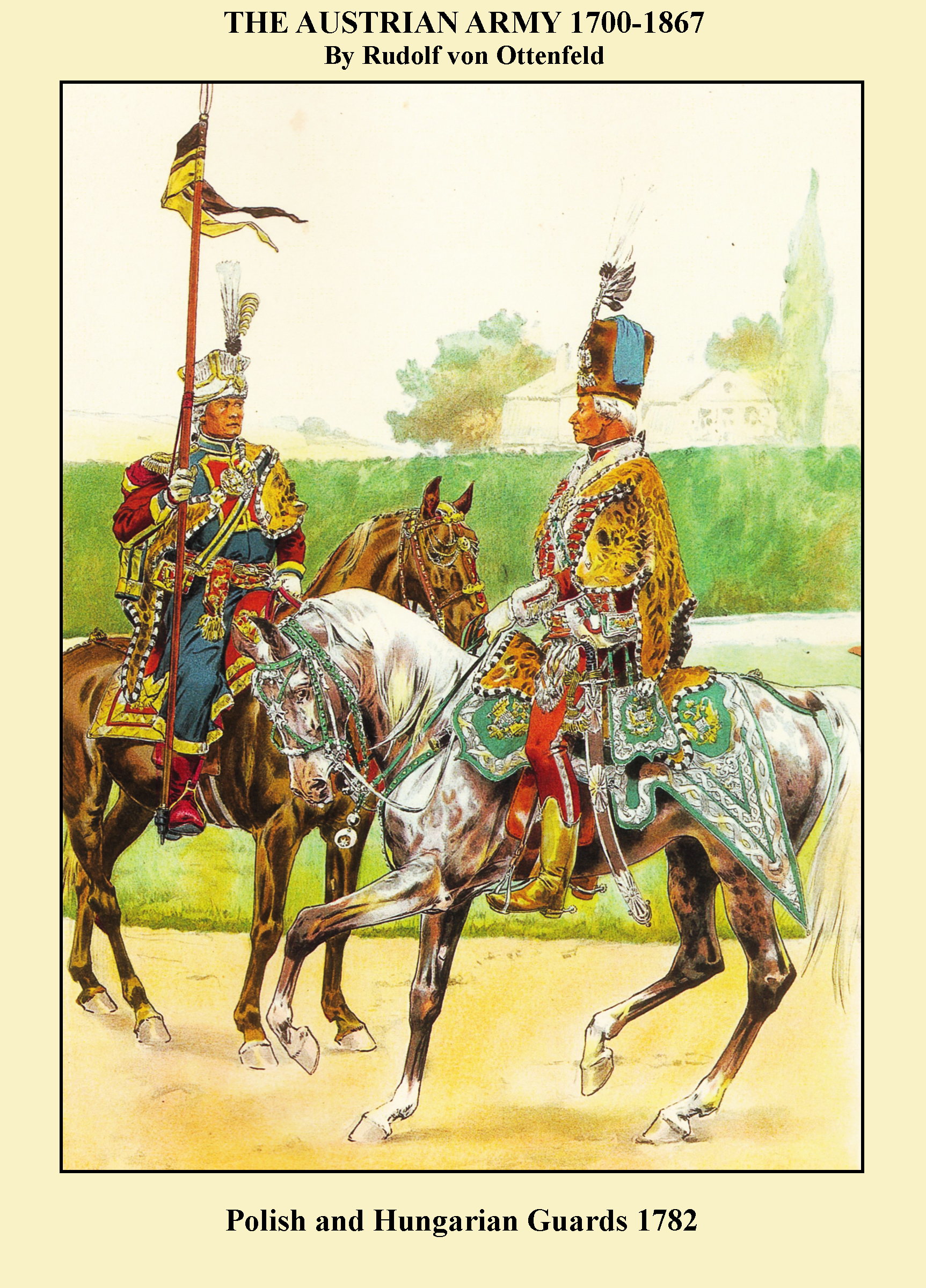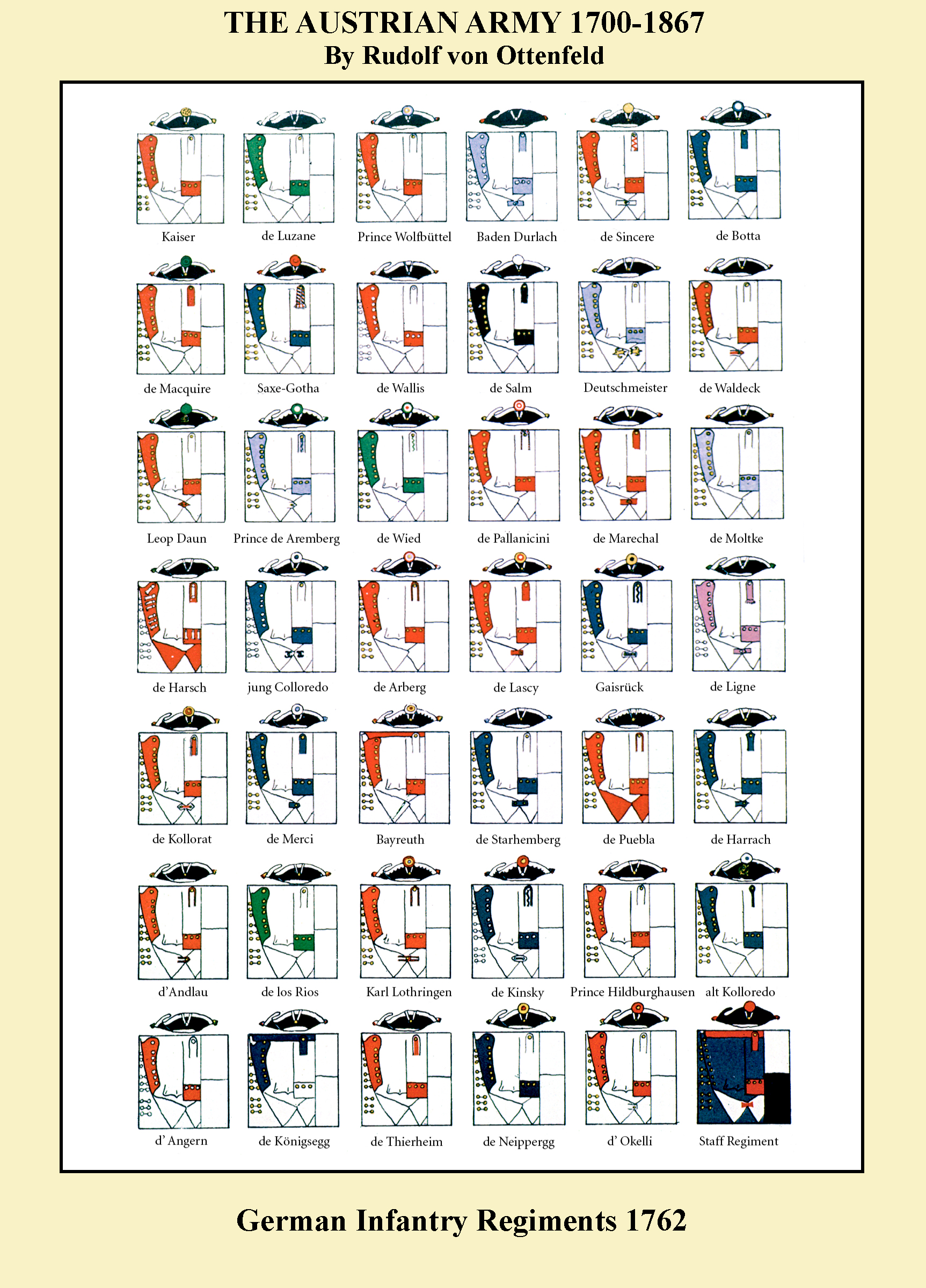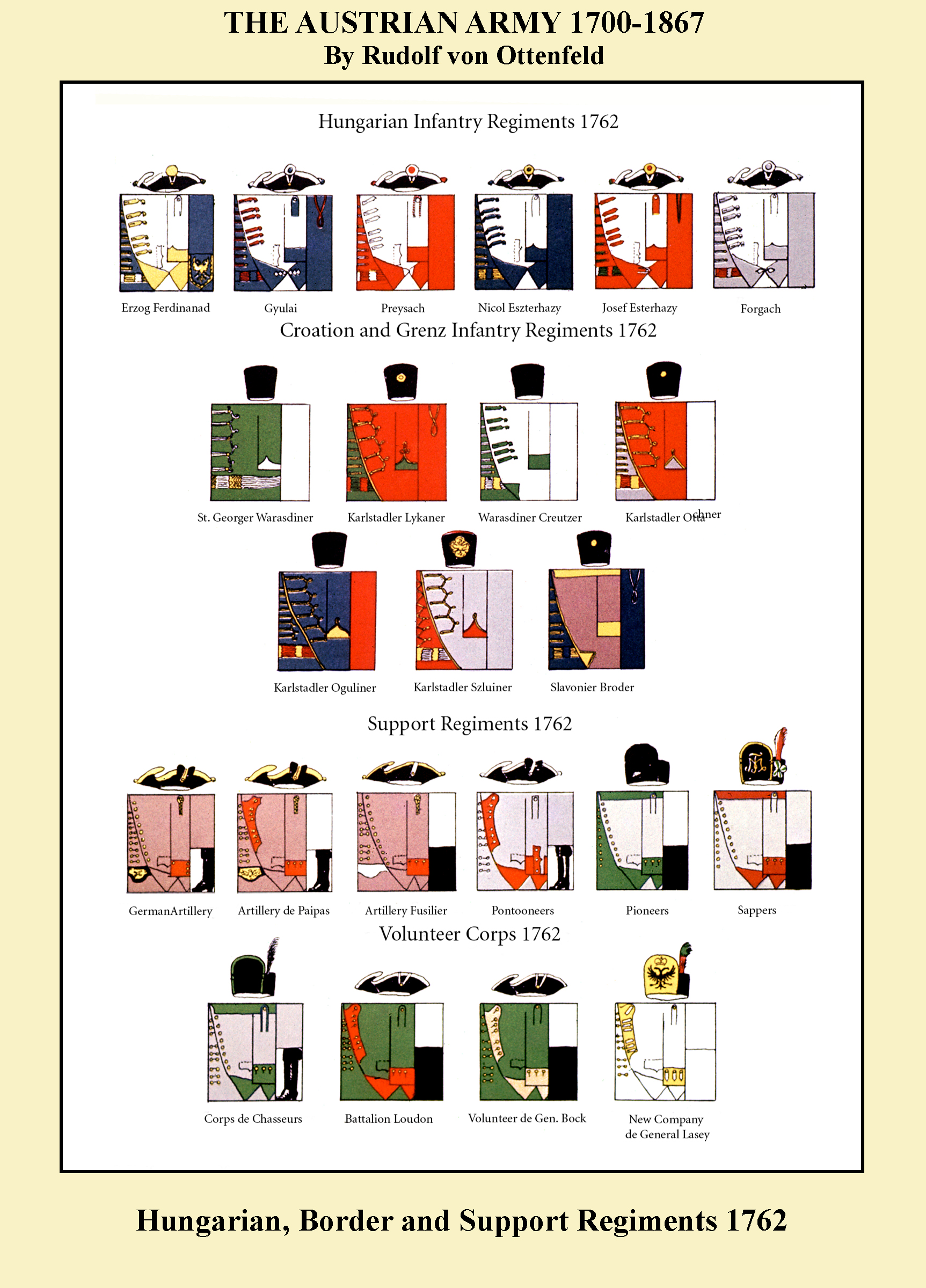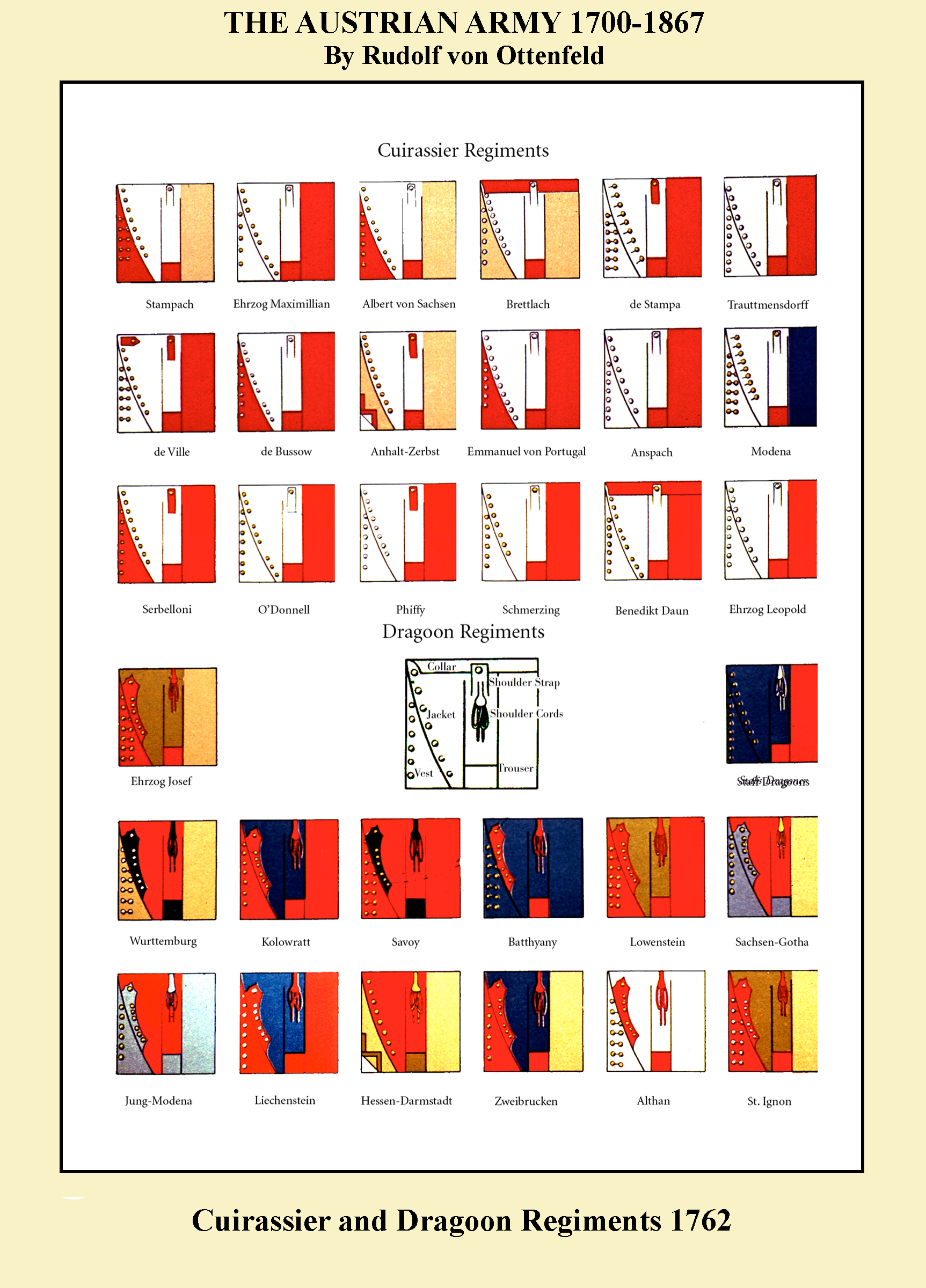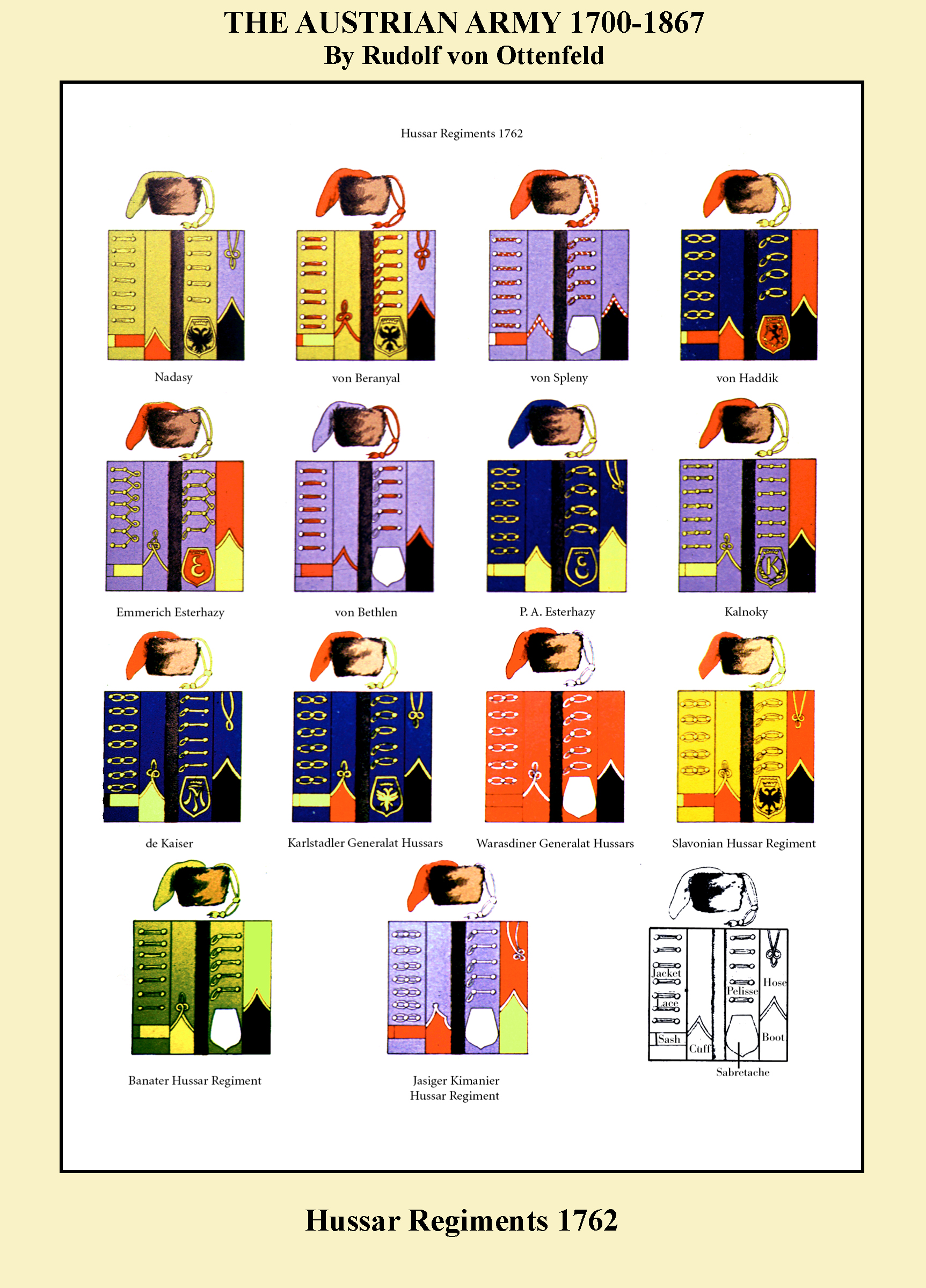THE WORLD OF MILITARY UNIFORMS
1660-1914
THE AUSTRIAN ARMY 1700-1867
By Rudolf Otto von Ottenfeld
Page 2
General Officers 1760
General Officers wore formal uniforms from 1751. The white coat with red facings and breeches became characteristic of Hapsburg generals for the remainder of the dynasty. The officers shown in the plate are a Major-General (General de Bataille or General-Feldwachtmeister) on the left and General of Cavalry (General der Cavallerie) on the right. The highest rank of the time was Field-Marshall (Feldmarschall). The rank of General was usually referred to as Feldzugmeister.
The rank was indicated by the amount of gold lace on the coat and the number of loops on the cuff.
The Austrian Army of the 18th Century
Continued
Engineers, Pioneers and Pontonniers 1760
The Engineering branch, like many of the military institutions of Maria Theresa’s reign, were considered the most efficient in Europe. Established soon after her accession, the corps grew to four ‘brigades’ with over twenty engineers in each. The Sapper companies were formed in 1760 into three companies commanded by Engineers. The uniform of the Engineer Corps was originally white lined red but changed in 1760 to a light grey-blue with crimson facings. The sappers wore pike grey with crimson facings and the kaskett, a high fronted cap (like the Spanish dragoons). The front was edged in white tape and it bore a brass disc with the royal cypher stamped on it.
There was a Miner’s corps originally attached to the Artillery and wearing the same uniform, but they were united with the sappers in 1771. A Pioneer Corps was raised in 1758 and wore the same uniform as the sappers with green facings and a plain black leather kaskett. At about the same time a Pontonnier Corps was established wearing the same uniform as the sappers with red facingas, a plain leather kaskettt with the royal cypher in brass and a red over white plume on the right side. Both the latter units were disbanded in peace time.
Grenadiers and Musicians German Infantry 1769-1798
Grenadiers now wore a more conventional fur cap with rounded top. The cap plate bore a trophy of arms with grenades and the royal cypher above. Note the brass cartridge cap worn on the cross belt. Musicians distinctions took on the familiar look they would retain for nearly a century. The wings were in facing color and they, the cuffs and collar were edged with scalloped lace. A white figure was placed in the center of the wings. The Drum is plain brass with dark yellow and black stripes around the hoops. Note the large brass case for the fife worn on the right side of the musician on the left..
Fusiliers of German Infantry 1769-1798
The uniforms of the Austrian army went through a major change in 1769. Many of these changes were the result of economies as the last ten years of Maria Theresa’s reign were lean ones. The white coat now lost its lapels and became much plainer, fastening down the front with ten buttons. Facings were worn on the turned down collar and the smaller round cuffs which had two buttons on the top edge and two at the rear. The skirts were somewhat shorter and turned back showing the facing color. The most dramatic change was in the headdress which was most modern in appearance being a leather kaskett like that of the sappers with a brass plate on the front bearing the Royal Cypher. Equipment was much the same as before except that the waistbelt was worn over the coat making the whole uniform years ahead of its time. Shown here is a fusilier of a line regiment in marching order.
Hungarian Infantry 1770-1798
The regulations of 1767 deprived the Hungarian regiments of much of their individuality. Gone were the colored loops across the chest and the red pants. The only evidence of their national distinction would henceforth be the tight pants with black and yellow lace down the sides and a knot of the same lace on the thighs. The cuffs of Hungarian regiments were now decorated with a loop of lace that became known as the ‘bear claw’. As with the regular infantry, these characteristics would remain a feature of the Hungarian infantry until 1918.
Dragoons, Chevaulegers and Hussars 1769-1798
The cavalry were not immune from the 1767 regulations which standardized much of the dress of the Hapsburg Army. Dragoons were now entirely in white and not surprisingly wore a uniform much like the of the infantry except for the high boots and shorter skirts on the buttoned over coat. Those regiments converted to Chevaulegers, like the figure on the left in the plate, wore the same uniform as the dragoons only in light green with white breeches. The kaskett was similar to that worn by the infantry except that it was higher and edged with yellow or white lace. Hussar uniforms ( On the right in the plate) were also standardized with each regiment’s dolman, pelisse and breeches being the same color. Dark blue, light blue, dark green and parrot green were the colors allotted to groups of two to four regiments. The loops across the chest, on the pelisse and on the breeches were now a universal yellow and black lace. They also now wore a peakless shako with a plume emanating from a large yellow on black cockade in front. The shako colors were black, red, green, grey and light blue. The fur caps were retained for a few years by officers and senior NCOs. A new type of cavalry had also made its appearance; the Ulan or lancer. These horsemen from Polish Galicia wore green white or green uniforms and the national headdress, the Tschapka.
Cuirassiers 1769-1798
The uniforms of Cuirassiers were also simplified after 1767. The jacket was now single breasted with regimental facing colours replacing the red. The eight regiments had facing colours as follows- 1. Dark Red, 2. Black, 3. Pompadour Red, 4. Grass Green, 5. Light Blue, 6. Black, 7. Dark Blue and 8. Scarlet. The cuirasses continued to be blackened. The tricorn hat now fitted with a black over yellow plume was changed to bicorne in 1780.
Border Troops 1770-1798
Regularizing the uniforms of the wild border troops was not an easy task. but the 1767 changes did affect them. For the regular border infantry, a brown coat of infantry cut was now ordered. Facings of different colors for the various regiments were worn on collar and cuffs and the headdress varied from felt peakless shakos to fur caps to infantry kasketts. The breeches were of Hungarian style in white or light blue. Some units such as the Szluiner sharpshooter on the left in the plate wore uniforms almost identical to Hungarian infantry. Cavalry, such as border hussars still wore their colorful uniforms, but some units such as the Wallachian dragoons were dressed as chevaulegers only with a brown coat instead of green..
Surgeons and Invalides 1780-1790
Like most armies at the time, medical services were at best rudimentary in the Austrian Army. The surgeon shown in the plate would be typical (although it is dated later than the Seven Years War); an older gentleman completely unfit for active service. By the middle of that war the medical services had at least become regulated somewhat and medical officers in the field had to have been certified. However, there was no stretcher corps or medical orderly unit and wouldn’t be till he middle of the next century. The surgeon’s uniform was established in 1781. In common with veterans all over Europe, the Invalide corps wore a simpler version of the uniform worn by the regular infantry.
Military Officials and Academy Instructors 1780-1790
When it came to military bureaucracy, Austria was the leading proponent in Europe. Departments for medical, supply, transport, pay ordnance, education and a host of other arcane offices abounded. There were military academies for most branches. The brown coated officer shown was from the Vienna-Nieustadter Artillery Academy. The garrison and invalide officers are dressed as most officials.
Guard Units 1769-1790
Unlike the Guard cavalry and infantry fighting units of most other European Armies, the Hapsburg army had no such thing. Their Guard units were non-combatant to a man and made up of the most noble of the population. The Trabanten, Archer and other Guards were of ancient origin. Shown above are two elaborately dressed mounted units – the Hungarian and Polish (Galician) Guards.
Austrian Uniform Charts 1762
Below are the uniform charts for 1762. It is interesting to note that these were the only charts he produced.
NEXT PAGE
THE AUSTRIAN ARMY OF THE NAPOLEONIC WARS.

